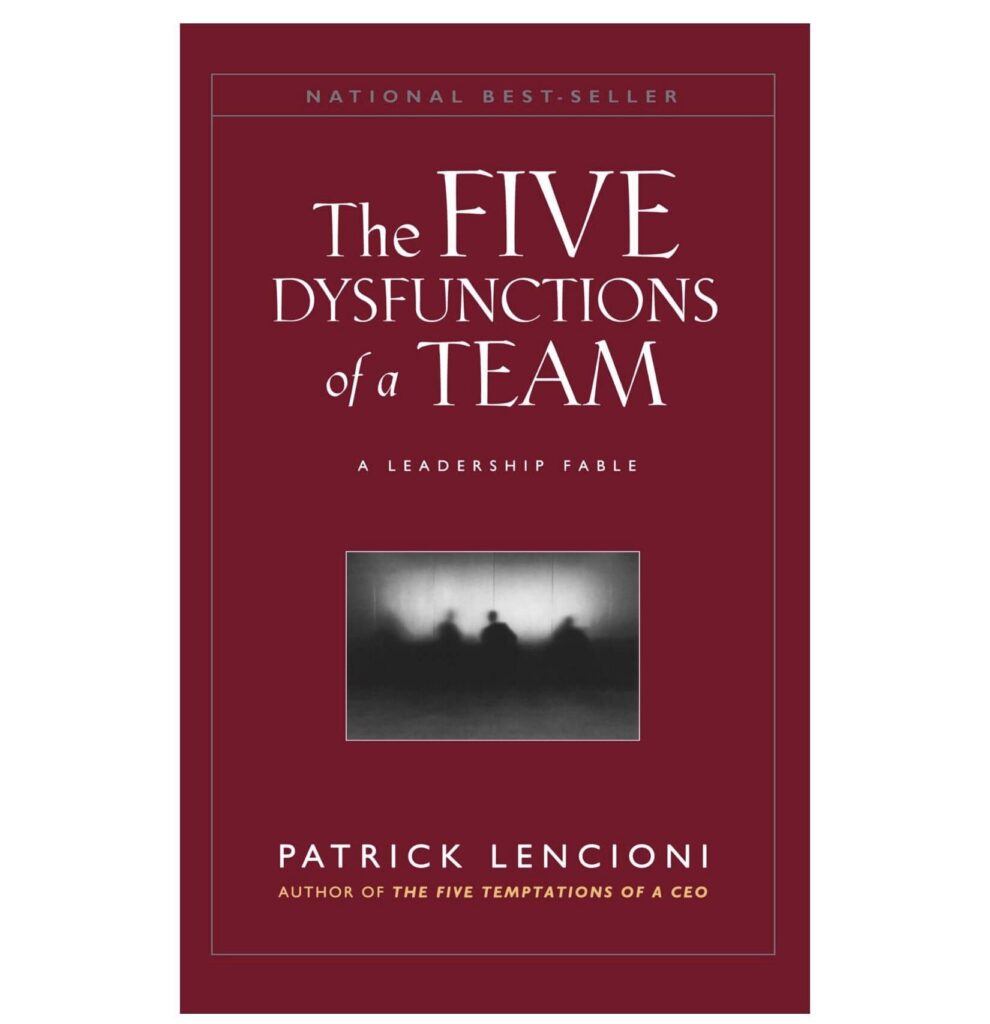
Dans le monde professionnel, une équipe efficace est plus que la somme de ses parties. Cependant, beaucoup d’équipes se retrouvent entravées par des dysfonctionnements qui les empêchent d’atteindre leur plein potentiel.
Dans son livre, « Les 5 dysfonctionnements d’une équipe », Patrick Lencioni parle des obstacles communs que rencontrent de nombreuses équipes. Il en a consolidé un modèle fascinant et perspicace et propose quelques pistes pour les surmonter.
Je vous propose ici de les explorer ensemble !
Historique

L’idée que les équipes peuvent dysfonctionner n’est pas nouvelle. Cependant, Patrick Lencioni a consolidé et simplifié ces dysfonctionnements dans un modèle accessible et facilement compréhensible. Pour mieux appréhender son modèle, explorons d’abord le développement historique de la pensée autour de la dynamique des équipes.
| Intitulé | Période | Description | |
|---|---|---|---|
| 1 | 1ères observations sur la dynamique de groupe | 1940 – 1950 | Dans cette période, la dynamique des groupes est devenue un sujet d’étude sérieux. Des chercheurs comme Kurt Lewin étudient la manière dont les groupes se forment, prennent des décisions et résolvent les conflits. |
| 2 | Modèle de Tuckman | 1960 | Bruce Tuckman introduit son célèbre modèle des étapes de développement des équipes. « Forming, Storming, Norming, et Performing » pose ainsi les bases d’une compréhension plus approfondie des défis des équipes. |
| 3 | L’évolution de la Culture d’Entreprise | 1980 – 1990 | Avec la mondialisation croissante, les entreprises ont commencé à reconnaître l’importance de la collaboration inter-fonctionnelle et inter-culturelle. Cette période a vu une augmentation de la littérature sur le leadership d’équipe, l’intelligence émotionnelle et la gestion des conflits. |
| 4 | Introduction du Modèle de Lencioni | 2000 | Lencioni introduit son modèle des cinq dysfonctionnements. Sa particularité est qu’il identifie les obstacles qui empêchent une équipe d’être efficace, quelle que soit sa maturité. |
| 5 | L’ère Actuelle | Aujourd’hui | Avec l’ascension du travail à distance, la collaboration des équipes est devenue plus complexe que jamais. Cependant, les fondements posés par ces penseurs restent pertinents et offrent des outils précieux pour naviguer dans ce paysage changeant. |
Ainsi, le modèle de Lencioni s’inscrit dans une longue tradition de recherche et de réflexion sur la dynamique des équipes. Toutefois, sa simplicité et sa focalisation sur des obstacles concrets en font un outil particulièrement précieux pour les leaders d’aujourd’hui.
Les 5 dysfonctionnements d’une équipe

Lencioni a élaboré son modèle en se basant sur ses observations et son expérience avec de nombreuses équipes de direction. Au fil des années, il a identifié des schémas récurrents de comportements qui entravaient la performance des équipes.
En les analysant, il a consolidé ces observations en cinq dysfonctionnements majeurs. Il les présente alors de manière hiérarchique, où chaque dysfonctionnement construit sur le précédent.
Le modèle est le fruit de ses expériences concrètes, plutôt que d’une recherche académique traditionnelle.
1. Absence de confiance

Il est considéré comme la base sur laquelle reposent tous les autres dysfonctionnements. En effet, sans confiance, il est difficile voire impossible de construire une équipe soudée et performante.
Lorsqu’il y a absence de confiance au sein d’une équipe, les membres hésitent à se montrer vulnérables devant leurs collègues. Cette vulnérabilité ne concerne pas seulement les compétences professionnelles. Elle englobe également les peurs, les erreurs, les faiblesses, les besoins d’aide et les préoccupations.
Si les membres d’une équipe craignent d’être jugés, ridiculisés ou exploités en montrant leur véritable soi, alors la confiance est probablement absente.
| Note : Il y a donc un lien direct avec la sécurité psychologique. |
| Origines | Conséquences |
|---|---|
| – Traumatismes passés : Méfiance découlant de diverses expériences antérieures. – Malentendus persistants : Issues de malentendus non résolus entre membres. – Relations superficielles : Absence d’occasions de construire des relations solides et authentiques entre les membres. | – Protection et dissimulation : Les équipes sans confiance cachent leurs erreurs et hésitent à demander de l’aide ou à donner des retours constructifs. – Collaboration entravée : La collaboration est limitée car les membres craignent de prendre des risques interpersonnels. – Défense et justifications : Les équipes sans confiance perdent du temps et de l’énergie à défendre leurs actions et leurs intentions. |
Solution de Lencioni
Encourager la vulnérabilité.
Il suggère que les équipes passent du temps ensemble, partagent des expériences personnelles, admettent leurs erreurs et demandent de l’aide.
2. Peur du conflit

Ce dysfonctionnement découle directement du premier dysfonctionnement, l' »Absence de confiance ». Lorsque les équipes n’ont pas une base solide de confiance mutuelle, elles évitent souvent les désaccords et les conflits, même si ces derniers sont nécessaires et productifs.
| Origines | Conséquences |
|---|---|
| – Culture organisationnelle : Dans certaines cultures ou organisations, le conflit est perçu comme négatif ou inapproprié, ce qui conduit les employés à l’éviter. – Expériences passées : Les individus ayant eu de mauvaises expériences avec des conflits dans le passé peuvent être réticents à s’engager dans des désaccords. – Éviter le malaise : Les confrontations peuvent être inconfortables, et certaines personnes préfèrent éviter ce malaise même si cela signifie éviter une discussion nécessaire. | – Évitement des désaccords : Les équipes qui craignent le conflit évitent souvent les discussions difficiles ou controversées. Elles peuvent se contenter de conversations superficielles et éviter les sujets qui pourraient mener à des désaccords. – Manque de transparence : Les membres de l’équipe peuvent retenir leurs opinions ou préoccupations, en particulier si elles sont en désaccord avec le groupe ou avec des personnes influentes au sein de l’équipe. – Décisions non optimales : Sans un débat ouvert sur les idées et les stratégies, les équipes risquent de prendre des décisions qui ne sont pas les meilleures possibles. – Ressentiment latent : Lorsque les préoccupations et les désaccords ne sont pas exprimés ouvertement, ils peuvent s’accumuler et conduire à un ressentiment latent. Cela peut éclater plus tard sous forme de conflits plus grands ou causer une tension continue au sein de l’équipe. – Conflits passifs : Au lieu d’aborder les désaccords de manière directe, les équipes peuvent s’engager dans des comportements passifs-agressifs, des commérages ou des silos. |
Ainsi, l’objectif n’est pas d’éliminer le conflit, mais d’apprendre à le gérer de manière constructive.
Solution de Lencioni
Les équipes doivent comprendre que le conflit est productif.
Il encourage une culture où les désaccords sont acceptés et où les débats sont orientés vers des solutions, sans devenir personnels.
3. Manque d’engagement

Ce dysfonctionnement s’ensuit naturellement de la « Peur du conflit », car sans conflits sains et ouverts, les équipes ont du mal à s’engager pleinement derrière les décisions.
| Origines | Conséquences |
|---|---|
| – Absence de clarté : Si les objectifs, les attentes ou les responsabilités ne sont pas clairement définis, les membres de l’équipe peuvent avoir du mal à s’engager. – Peur de l’échec : Certains membres de l’équipe peuvent hésiter à s’engager par crainte de l’échec ou de la critique. – Manque de contribution : Si les membres de l’équipe sentent qu’ils ne peuvent pas contribuer ou influencer les décisions, ils peuvent se retirer et ne pas s’engager pleinement. – Conflits non résolus : Comme mentionné précédemment, si les équipes ne traitent pas les conflits de manière saine, cela peut conduire à un manque d’engagement. | – Ambiguïté et Indécision : Dans les équipes souffrant d’un manque d’engagement, les décisions ne sont souvent pas claires ou ne sont pas prises du tout. Il peut y avoir une ambiguïté autour de la direction à prendre ou des responsabilités. – Apathie : Les membres de l’équipe peuvent sembler indifférents ou désintéressés par le travail de l’équipe. Ils peuvent ne pas participer activement aux discussions ou aux activités de l’équipe. – Absence d’achat : Même si une décision est prise, tous les membres de l’équipe ne peuvent pas la « acheter » ou la soutenir pleinement. Ceci est particulièrement vrai si les membres se sentent comme s’ils n’avaient pas eu l’occasion d’exprimer leurs opinions ou préoccupations. – Fuite des responsabilités : Sans un engagement fort, les membres de l’équipe peuvent éviter de prendre la responsabilité de leurs actions ou des résultats. – Rediscuter les décisions : Les équipes qui manquent d’engagement peuvent se retrouver à rediscuter constamment les mêmes sujets parce qu’elles n’arrivent pas à une conclusion ou à un consensus. |
Solution de Lencioni
Lencioni suggère de créer une culture où les décisions sont prises en se basant sur la discussion et la clarté.
Si une décision unanime n’est pas possible, l’équipe doit au moins s’engager à soutenir la décision prise.
4. Evitement de la responsabilité

Lorsque les membres de l’équipe ne sont pas pleinement engagés ou alignés sur les objectifs, il est courant qu’ils évitent de prendre leurs responsabilités, surtout lorsque des défis surgissent. Ce dysfonctionnement émerge donc souvent comme une conséquence des précédents, notamment du « Manque d’engagement ».
| Origines | Conséquences |
|---|---|
| – Manque de clarté : Si les responsabilités et les attentes ne sont pas clairement définies, les membres peuvent avoir du mal à comprendre ce qui est attendu d’eux. – Peur des conflits : Tenir quelqu’un responsable peut être inconfortable et peut mener à des désaccords. Si l’équipe craint le conflit, elle peut éviter ces confrontations nécessaires. – Culture organisationnelle : Dans certaines organisations ou équipes, il peut y avoir une culture de non-imputabilité, où les erreurs sont balayées sous le tapis ou vues comme inévitables. – Dynamiques de l’équipe : Les dynamiques interpersonnelles, telles que la favoritisme ou les alliances, peuvent également empêcher les membres de se tenir mutuellement responsables. | – Imputabilité limitée : Les membres de l’équipe peuvent hésiter à se tenir mutuellement responsables de leurs actions, performances ou comportements. Ceci conduit à une culture où les normes d’excellence peuvent glisser. – Tolérance aux standards bas : Les équipes peuvent commencer à tolérer des résultats médiocres ou une performance inférieure à la normale sans aborder directement le problème. – Conflits non résolus : Les problèmes ou les préoccupations ne sont pas abordés directement, mais peuvent plutôt être discutés en dehors du groupe, conduisant à des commérages ou des silos. – Fuite des responsabilités individuelles : Les membres peuvent blâmer les autres, les circonstances extérieures ou éviter complètement d’admettre leurs erreurs ou insuffisances. – Résultats médiocres : L’incapacité de tenir les membres responsables conduit souvent à des résultats inférieurs aux attentes, car il n’y a pas de pression pour s’améliorer ou rectifier les erreurs. |
Solution de Lencioni
Les membres de l’équipe doivent s’appeler mutuellement à la responsabilité,
établissant des normes claires et se rappelant constamment les objectifs de l’équipe.
5. Inattention aux résultats

Le dysfonctionnement « Inattention aux résultats » est le cinquième et dernier des dysfonctionnements d’une équipe présentés par Patrick Lencioni. C’est souvent le symptôme le plus visible des dysfonctionnements sous-jacents. Quand une équipe ne se concentre pas sur les résultats, elle peut s’égarer et ne pas accomplir ses objectifs primordiaux.
| Origines | Conséquences |
|---|---|
| – Absence de vision claire : Si l’équipe n’a pas une compréhension claire de ses objectifs ou de sa mission, elle peut se disperser et se concentrer sur des tâches secondaires. – Récompenses mal alignées : Si les systèmes de récompense encouragent les succès individuels plutôt que le succès collectif, cela peut conduire à une inattention aux résultats de l’équipe. – Dysfonctionnements antérieurs : Comme mentionné, les autres dysfonctionnements (manque de confiance, peur du conflit, manque d’engagement et évitement de la responsabilité) peuvent tous contribuer à une inattention aux résultats. – Communication insuffisante : Si l’équipe ne communique pas régulièrement sur les progrès, les défis et les résultats, elle peut perdre de vue son objectif principal. | – Priorités individuelles : Les membres de l’équipe peuvent privilégier leurs réussites personnelles, leur statut ou leur ego plutôt que le succès collectif de l’équipe. – Manque de concentration : L’équipe peut se disperser dans diverses directions sans un objectif clair, perdant de vue le but principal. – Complaisance : Les équipes peuvent se satisfaire du statu quo et ne pas aspirer à l’excellence ou à la réalisation de leurs objectifs. – Non reconnaissance des échecs : Plutôt que d’admettre et d’analyser les erreurs ou les échecs, l’équipe peut les ignorer ou les minimiser. – Faible motivation : Sans un objectif clair et une attention aux résultats, la motivation de l’équipe peut diminuer, ce qui peut entraver la performance. |
Solution de Lencioni
Il faut mettre l’accent sur les objectifs de l’équipe plutôt que sur les égo.
Lencioni recommande de célébrer les réussites collectives et de se concentrer sur des objectifs clairs et mesurables.
Points d’attention

Le modèle des cinq dysfonctionnements d’une équipe de Patrick Lencioni offre une structure solide pour comprendre et aborder les problèmes courants au sein des équipes. Cependant, comme tout modèle, il a ses limites et il y a certains points d’attention à considérer lors de son utilisation :
| Libellé | Description | |
|---|---|---|
| 1 | Universalité vs. Spécificité | Bien que le modèle de Lencioni identifie des problèmes communs à de nombreuses équipes, chaque équipe est unique. Il est important de reconnaître que toutes les équipes ne traverseront pas nécessairement chaque dysfonctionnement ou ne les vivront pas de la même manière. |
| 2 | Simplicité du modèle | Alors que le modèle est présenté de manière linéaire, les dynamiques d’équipe sont souvent plus complexes. Par exemple, une équipe peut simultanément lutter contre plusieurs dysfonctionnements. |
| 3 | Origines des dysfonctionnements | Le modèle se concentre sur les symptômes observables mais ne traite pas toujours des causes profondes qui peuvent varier considérablement d’une équipe à l’autre. |
| 4 | Réaction défensive | L’identification directe des dysfonctionnements peut parfois provoquer une réaction défensive de la part des membres de l’équipe, surtout si elle est présentée sans tact ou sans une approche constructive. |
| 5 | Dynamiques culturelles | Les équipes multiculturelles peuvent présenter des défis supplémentaires, car certaines cultures peuvent avoir des approches différentes de la confiance, du conflit et de l’engagement. Le modèle peut nécessiter une adaptation ou une interprétation différente dans ces contextes. |
| 6 | Mise en œuvre | Sans un accompagnement approprié, comme celui d’un coach d’équipe ou d’un facilitateur expérimenté, l’identification des dysfonctionnements pourrait ne pas conduire à des solutions efficaces. |
Pour utiliser efficacement le modèle de Lencioni, il est essentiel de l’aborder avec une ouverture d’esprit, une volonté d’adapter et de personnaliser selon les besoins spécifiques de l’équipe, et un engagement à prendre des mesures concrètes pour aborder les dysfonctionnements identifiés.
Questions fréquentes

Toutes les équipes traversent-elles chacun de ces dysfonctionnements ?
Non, chaque équipe est unique. Si certaines équipes peuvent rencontrer tous ces dysfonctionnements, d’autres peuvent en affronter seulement quelques-uns ou même aucun. Cependant, ce modèle sert de guide pour identifier et résoudre les problèmes potentiels.
Est-il nécessaire de traiter ces dysfonctionnements dans un ordre précis ?
Lencioni présente les dysfonctionnements dans un ordre hiérarchique, commençant par l’absence de confiance. Toutefois, chaque équipe devrait évaluer où elle se situe et aborder les dysfonctionnements selon ses besoins spécifiques.
Comment savoir si notre équipe souffre d’un ou plusieurs de ces dysfonctionnements ?
Les symptômes comme les conflits non résolus, le manque d’engagement ou de responsabilité, et les résultats décevants peuvent être des indicateurs. Des évaluations d’équipe ou l’intervention d’un coach peuvent aussi aider à identifier ces dysfonctionnements.
Ce modèle est-il pertinent uniquement pour les équipes professionnelles ?
Non, bien que le modèle ait été développé dans un contexte professionnel, ses principes peuvent s’appliquer à tout type d’équipe. Par exemple des associations sportives, des organisations bénévoles ou encore des groupes communautaires.
Combien de temps faut-il pour surmonter ces dysfonctionnements ?
Cela dépend de la gravité du dysfonctionnement et de l’engagement de l’équipe à le résoudre. Certaines équipes peuvent voir des améliorations rapidement, tandis que d’autres peuvent nécessiter plus de temps et d’efforts.
Ce modèle prend-il en compte les différences culturelles ou générationnelles au sein des équipes ?
Le modèle identifie des problèmes universels, mais chaque équipe doit l’adapter à son contexte culturel ou générationnel pour assurer son efficacité.
Comment savoir si notre équipe a surmonté ces dysfonctionnements ?
Une amélioration de la communication, une augmentation de l’engagement, une plus grande responsabilité, et une meilleure performance sont des signes indiquant que l’équipe est sur la bonne voie. De plus, des évaluations régulières peuvent aider à mesurer les progrès.
Conclusion

Naviguer dans le monde complexe du travail en équipe nécessite plus que de simples compétences techniques ; cela exige une compréhension profonde des dynamiques interpersonnelles.
Le modèle des cinq dysfonctionnements de Patrick Lencioni nous offre une carte précieuse pour détecter et rectifier les points d’achoppement les plus courants des équipes. En reconnaissant et en affrontant ces défis, du manque de confiance à l’inattention aux résultats, nous pouvons bâtir des équipes plus fortes, plus résilientes et finalement plus productives.
Comme dans tout voyage de transformation, la prise de conscience est un élément clé. Alors, posez-vous la question :
Où se situe mon équipe dans ce modèle, et quel est le premier pas pour aller de l’avant?
Pour aller plus loin
Voici quelques ressources complémentaires que vous pourriez trouver utiles :
| Livre | « The Five Dysfunctions of a Team« par Patrick Lencioni. | Le livre originel qui introduit le modèle est une lecture incontournable pour ceux qui souhaitent une compréhension profonde. |
| Livre | « Overcoming the Five Dysfunctions of a Team: A Field Guide« par Patrick Lencioni. | Un guide pratique pour les leaders et les membres d’équipe qui veulent mettre en application les concepts du modèle dans leur propre contexte. |
| Livre | « Team of Teams: New Rules of Engagement for a Complex World« par General Stanley McChrystal. | Une exploration de la manière dont la hiérarchie traditionnelle doit évoluer pour faire face aux défis du monde actuel. |
| Article | « The Discipline of Teams« par Jon R. Katzenbach et Douglas K. Smith (Harvard Business Review). | Un article classique qui explore la différence entre les groupes de travail et les véritables équipes. |
| Article | « High-Performing Teams Need Psychological Safety. Here’s How to Create It« par Laura Delizonna (Harvard Business Review). | Une exploration de l’importance de la sécurité psychologique au sein des équipes. |
| Vidéo | « The Power of Vulnerability« par Brené Brown. | Une exploration profonde de l’importance de la vulnérabilité et de la confiance dans les relations interpersonnelles. |
| Vidéo | « Why good leaders make you feel safe« par Simon Sinek. | Une perspective sur l’importance du leadership dans la création d’un environnement d’équipe sécurisé. |






